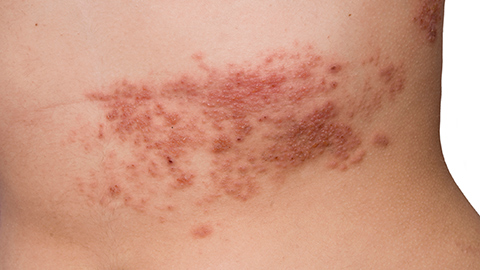
An older long-time client is on the table, midway through her massage. When the MT undrapes her leg, she finds a string of red blisters from the client’s buttock down the leg. “Oh, yeah, it’s kind of itchy,” says the client. In this episode, we talk about undiagnosed skin lesions, how carefully we need to communicate to clients about them, and take a deeper dive into shingles: what causes it, what the risks are, and whether massage therapists might catch it from clients.


This episode sponsored by Anatomy Trains, Yomassage, and Books of Discovery.
00:00 Speaker 1: Ruth Werner's best-selling book, A Massage Therapist's Guide to Pathology, is a highly regarded comprehensive resource that sets the standard for Pathology Education. Written for massage therapy students and practitioners, this ground-breaking resource serves up a comprehensive review of the pathophysiology, signs, symptoms, and treatment of more than 500 diseases and disorders. Learn more at booksofdiscovery.com.
[music]
00:39 Ruth Werner: Hi and welcome to I Have a Client Who, Pathology Conversations with Ruth Werner, the podcast where I will discuss your real-life stories about clients with conditions that are perplexing or confusing. I'm Ruth Werner, author of A Massage Therapist's Guide to Pathology, and I have spent decades studying, writing about, and teaching about where massage therapy intersects with diseases and conditions that might limit our client's health. We almost always have something good to offer even with our most challenged clients, but we need to figure out a way to do that safely, effectively, and within our scope of practice. And sometimes, as we have all learned, that is harder than it looks.
01:26 RW: In this episode, we're going to talk about a beloved long-time client who came in with a pretty common situation, but that presented some interesting challenges in terms of identifying our scope of practice, taking care of personal safety, and taking some care around our language and the way we communicate. So this story comes from a massage therapist in New York, who says, "I have a client who was 78 years old, she came to see me frequently. And one day she came in and I discovered in the middle of the session when I undraped her buttock and leg that she had a long line of red itchy blisters going down her leg, which somehow she didn't mention in her intake. When I asked her about it, she said, 'Oh yeah, that's been really itchy for the last few days. What do you think?'" Now, I wanna take a moment to say thank you so much to the massage therapist who shared this story with us. And I wanna invite you to share your I Have a Client Who stories. You can do that by sending them to ihaveaclientwho@abmp.com, that's ihaveaclientwho, all one word, all lowercase @abmp.com.
02:52 RW: So my thanks again to this massage therapist and to her client who have given us the opportunity to unpack a really common thing that happens in massage practice, which is someone will come in with an undiagnosed issue on their skin and they will ask you, "What you think is going on?" Well, what was going on for this lady, most likely is shingles. And we'll talk more about shingles in just a moment. But the way this came up in the middle of the session, where the therapist is already been working with her, rolls back the sheet and finds this rash, which had not been brought up in the intake interview. This presents something that happens to massage therapists all the time, and we have to be so careful about this. So what this massage therapist did, because she's been around the block and she knows what she's doing and she said, "This is a rash with blisters, and that means we have maybe the possibility of some infection or some other possibilities going on. We really need to reschedule you so that you get a chance to go in and see your doctor." And the lady asked her, "Could it just be a new detergent that I'm using or something like that?" And the therapist said, "You know, not my call, but because it's only on one leg, I would be surprised if it were your detergent." Ultimately, that's what they did. They rescheduled the massage session and the lady got in to see her doctor where she found out that indeed it was shingles.
04:33 RW: So this therapist did some good work in that she didn't say, "Oh my God, you have shingles, go to the doctor. You don't need to be getting a massage." Those are the words that might pop into our head to say, they are the words that need to not come out of our mouth. A, because that can sound really alarmist and scary and, B, because it's completely out of our scope of practice. Even if we're pretty sure that what we're seeing on the skin is what we think, we don't get to say so. All we can do in the way that preserves our ethics and our scope of practice is to decide whether we're going to continue to work with that person and how insistent we're going to be that they see a doctor before we work together again. I get a lot of questions about shingles from people who take my classes, so I wanna do a little bit of background about this situation. Because on behalf of this lady, this client who came in with shingles, and on behalf of the millions of other people who get shingle every year, it's worth it to know what we're talking about and to be prepared to act on this quickly because there are some complications that we would really, really like to avoid.
05:47 RW: So shingles is an infection brought about by a virus called the varicella-zoster virus or VZV. It is the same virus that causes chickenpox. Now, if you are my age, then you probably had chickenpox as a child. If you are substantially younger than I am, the chances are decent that you have had a chickenpox vaccine. Either way, most adults in this country, according to my research, it is 99.5% of adults in the United States are positive for antibodies to VZV, and that means somewhere along the line we have been exposed. And the good news about that is that that means we have already some inset resistance against new outbreaks with this virus. So the communicability of shingles is relatively low, not because the virus isn't communicable, it certainly is, but it's, the communicability is relatively low because the chances are excellent, you have already had it, and so you already have some protection.
07:01 RW: The way most people have their first iteration of the virus as we've said is as chickenpox, and this is... Oh, by the way, it's a herpes virus. And one of the things that the Herpesviridae have in common is we never really fully expel them from the body. So we'll have an outbreak of chickenpox, which typically looks like red blisters all over the body, with people who get it in a really severe way, those blisters might also be inside the mouth, and there's some evidence that they may even penetrate into the GI tract and the blisters last for a couple of weeks and then they subside. And we may never have any interaction with chickenpox ever again. But this virus likes to break the rules. And one of the ways it breaks this rule is we probably all know someone who's had chickenpox more than once. It's not fair, but it happens. Or the other thing that can happen is the virus will go into dormancy, and where it typically goes into dormancy is in a dorsal root ganglion, that's the collection site for the ganglia, the nerve cell bodies of our sensory neurons in the peripheral nervous system, or it may go into dormancy in a collection site in the trigeminal nerve. And it may never resurge again or it may resurge typically later in life, typically when the immune system is stretched a bit thin, and then the virus will reactivate. But it usually doesn't reactivate as chickenpox. It reactivates as this thing called shingles.
08:34 RW: Now, shingles doesn't look like shingles. The word shingles comes from the Latin cingulum, which means belt or strap, and it's called that because the way we see it is that the dermatome for the dorsal root ganglion that has been colonized by this virus, will grow blisters all along the length of that dermatome, which is why we tend to see them in a line or a band. Typically on one side of the body. And the way this lady had it, was going down her buttocks and down the back of her leg. But a lot of people get it in a stripe going along their rib cage, and some very unlucky people have the virus to reactivate in a branch of the trigeminal nerve, which can affect the eye or the jaw or the scalp, and be very, very uncomfortable. And in fact, if it affects the eye, then we can have complications of the eye, which may be associated with the possibility for a long-term damage.
09:37 RW: Another big difference between chickenpox and shingles is that while chickenpox is itchy, shingles usually hurts. Hurts like crazy. Maybe itchy for a few days, but then becomes extremely, extremely painful. And so it's lucky that this lady that was visiting the massage therapist was still in the itchy phase because it meant that by going to see her doctor and getting immediately on antivirals, she might have had the possibility of shortening the outbreak and may be preventing a really nasty complication that we see with shingles, especially in older people. And that complication is called postherpetic neuralgia or PHN. And this is a situation where the virus re-blooms, it heals, it goes back into dormancy, but the pain signals that it generated from those sensory neurons in the skin continue to generate, and can persist for a month or even for years. This becomes a self-fulfilling pain problem of central sensitization and it is as such really challenging to treat and to overcome. And so we would really like for people who have an outbreak of shingles as an adult to not develop PHN.
11:00 RW: So at this point, I have to talk a little bit about the V-word, vaccines. There is a chickenpox vaccine. It was licensed in 1995. Most school districts highly recommend the vaccine for students entering school. And here's the thing about chickenpox. It is, for most children, a relatively benign infection. It lasts for a few days, it's uncomfortable, it may spread and affect other kids, but most of the time, it is not dangerous. That most of the time doesn't count if you're one of the, between 20 and 200 children each year who died from complications related to chickenpox before there was a vaccine. Now there's a vaccine and that means fewer kids missing school from chickenpox and also fewer parents missing work to stay home and take care of kids. But this also means that those parents are not getting a re-exposure to the virus in adulthood. And so an interesting unexpected consequence of an effective and safe chickenpox vaccine for children is that we are... For a while, I have seen an increasing number of elders develop shingles, possibly because they miss this opportunity to sort of get a booster exposure to the virus. There is now a varicella-zoster booster shot for elders, which then reduces the risk of both shingles and postherpetic neuralgia.
12:41 RW: So that's a short summary about shingles. Again, I wanna emphasize, while the blisters are a chock-full of virus, it's probably not contagious to most people because most adults in the United States have already been exposed and already have antibody protection. But most is not all. And we would like to not be working with people who have contagious diseases in a transmissible or communicable form plus which, most of the time shingles hurts enough that people cancel appointments. It's unusual for us to see it in this sort of just starter phase before it really begins to be painful. But when we have a client who has an undiagnosed skin issue, especially when there are blisters involved and a risk of secondary infection, our most important choice is to keep them safe and that means to delay the massage until this rash has cleared up and until they have received appropriate treatment. So that's what I've got for your client with an undiagnosed rash that turns out to be shingles.
13:48 RW: Hey everybody, thanks for listening to I Have a Client Who, Pathology Conversations with Ruth Werner. Remember, you can send me your I Have a Client Who stories to ihaveaclientwho@abmp.com, that's ihaveaclientwho, all one word, all lowercase, @abmp.com. I can't wait to see what you send me and I'll see you next time.
[music]
14:18 S1: Yomassage is now offering ABMP Podcast listeners $100 off their 25-hour certification from now until September 1st with the code ABMP100. Don't miss this opportunity to take advantage of the biggest discount Yomassage has ever offered. Yomassage is revolutionizing the wellness industry by combining therapeutic touch, mindfulness, and restorative stretch. Take your career to the next level and become a certified Yomassage therapist. Learn more at yomassage.com.
14:57 S1: Anatomy Trains and the Laboratories of Anatomical Enlightenment are excited to invite you to Dissection Livestream, a regional and layered journey through the human body with Tom Myers and Todd Garcia. New dates coming soon. Student Jan Ball who attended the last dissection says, "The whole live stream dissection course was truly a unique educational experience. It was profoundly moving. I gained so much from it. It was one of the most valuable educational opportunities that I've had. I'm truly grateful to Tom, Todd, and the whole team of people involved who made this unique opportunity available." This experience will be delivered through Zoom webinar with high quality audio and video, multiple perspectives, and time for questions. Visit anatomytrains.com for dates and details.